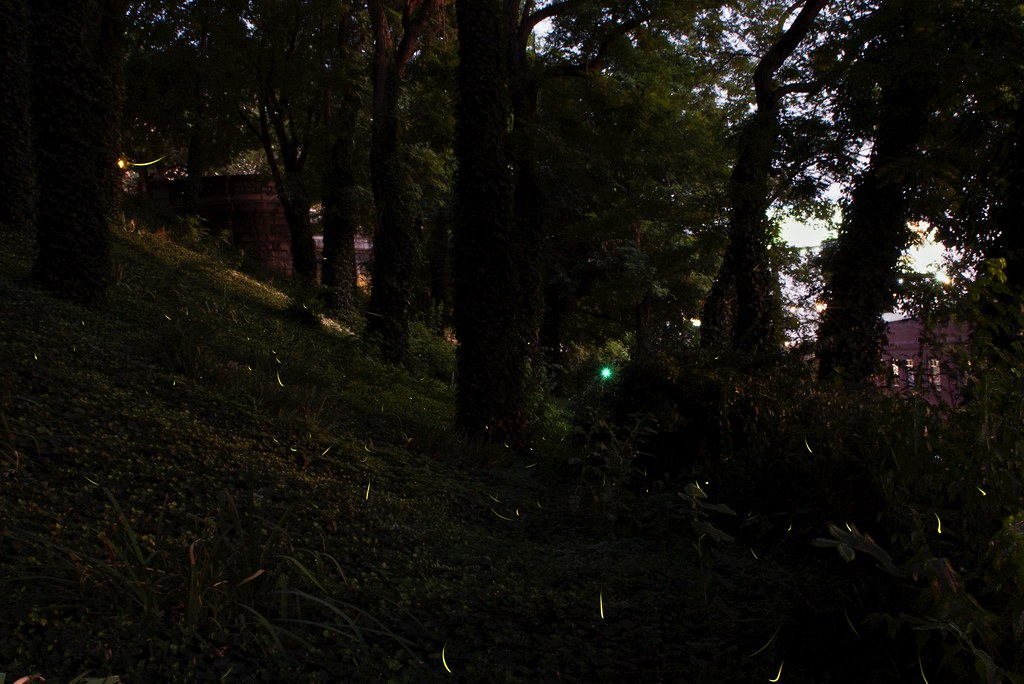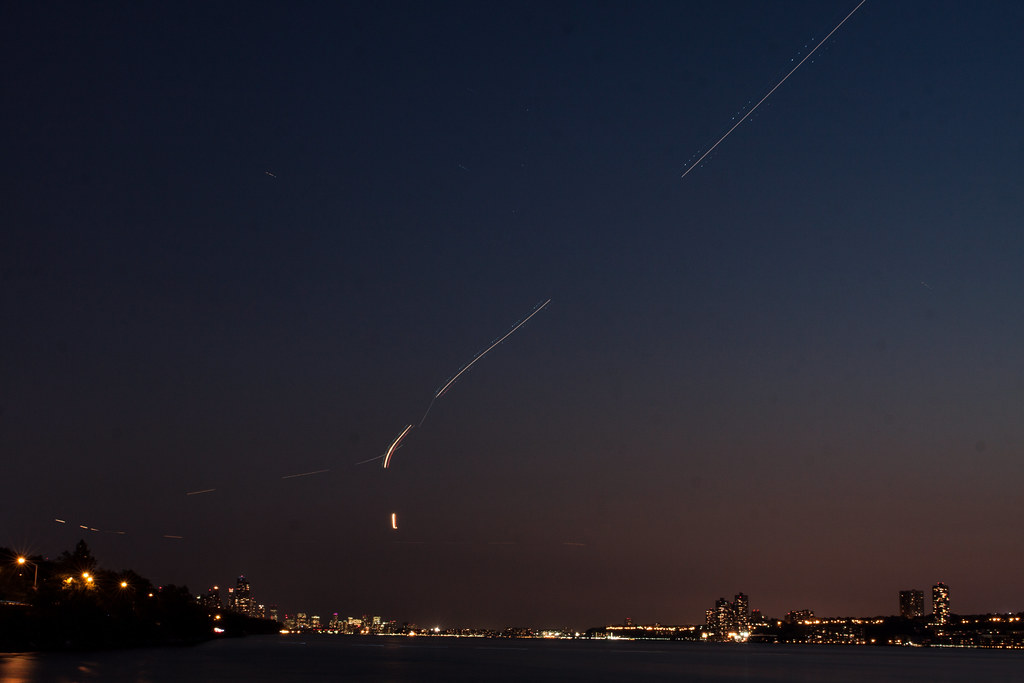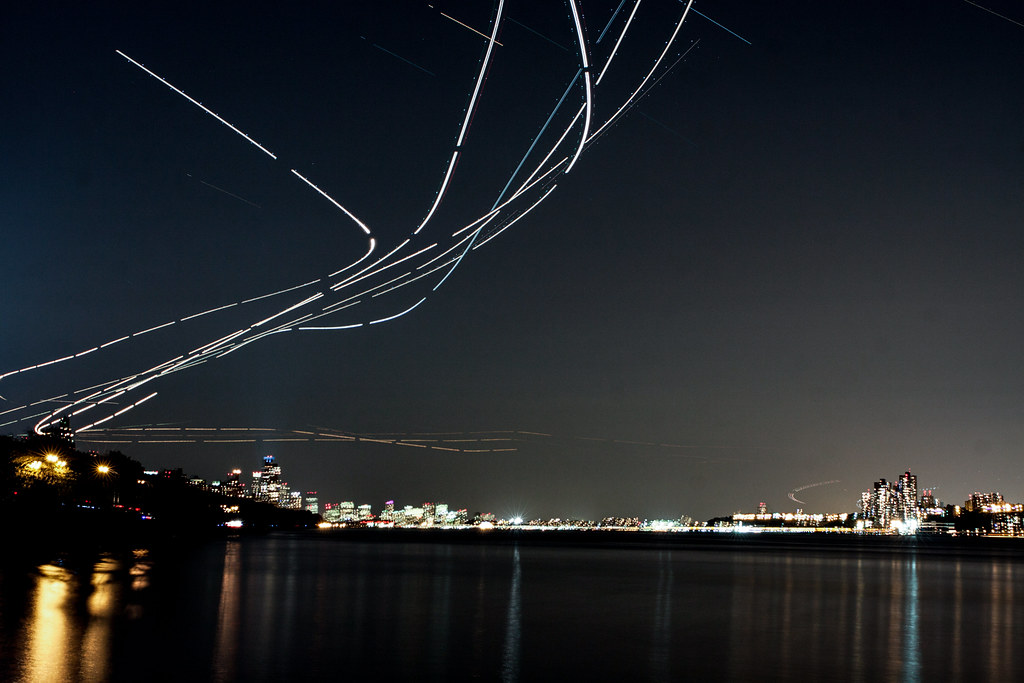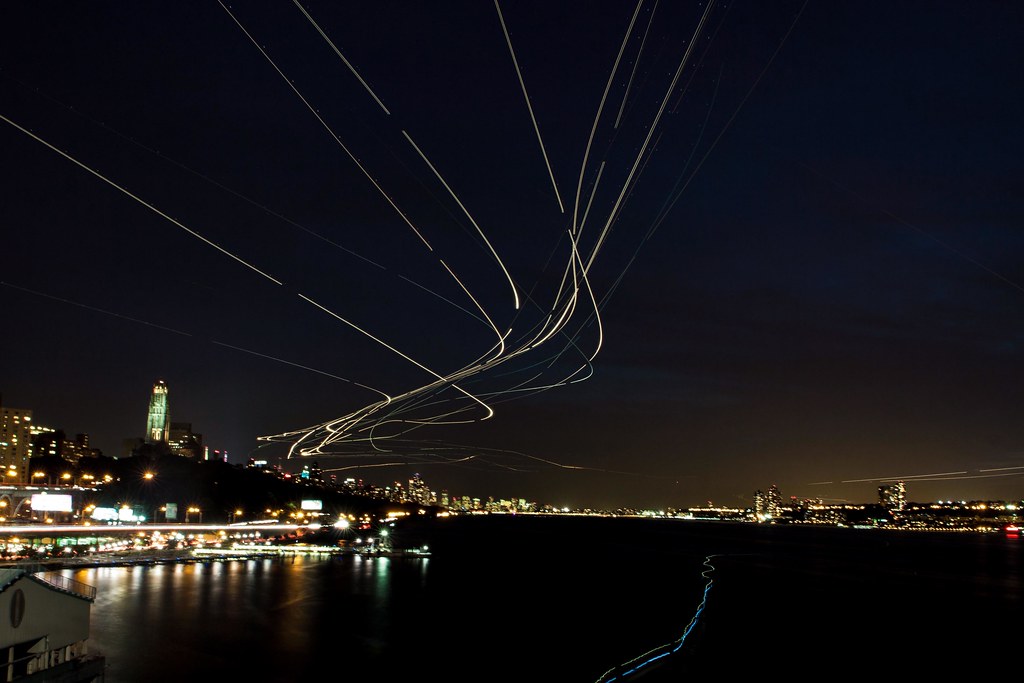Forums › Forums › Get Technical › Software › Astrofarktographers: Stacking Question
- This topic has 15 replies, 4 voices, and was last updated 11 years, 10 months ago by
ennuipoet.
-
AuthorPosts
-
September 13, 2012 at 4:46 pm #2818
ennuipoet
ParticipantOver the Summer, I tried my hand at stacking exposures to capture fireflies (the insect, not Captain Reynold’s ship) at night.

I did it Photoshop by stacking my images, setting the Layer Properties to “Difference” and merging the Layers, and it worked OKish.Now I am thinking of a slightly different project involving air traffic over Manhattan. http://freeversephotography.com/freeversephotoblog/2012/09/13/fly-by-night/# I want to shoot long exposures of the planes traversing the night sky and then stack the images. Except, I would like to do rather more than the five or six exposures I stacked for the fireflies. When you do Astro Stacking are you using specific software? Is it free? If not is it err…available through alternate supply channels.
I could do it in photoshop but that is an onerous and labor intensive project. I will do it if I must, but if there is an easier way…
September 13, 2012 at 5:10 pm #49007ravnostic
ParticipantStarStax is what you’re looking for here. It does more than just stars. I’ve had good results with lightning from it, stacking 30-40 meah pictures into one glorious image. The problem lay in that will only save in jpg. And while it will work with ‘darks, it doesn’t really. But the result overall, I felt, was worth it. Great for star trails, too. It’s free.
September 13, 2012 at 5:47 pm #49008ennuipoet
ParticipantAwesome Rav, that is just what I was looking for! Thanks!
September 13, 2012 at 7:30 pm #49009chupathingie
Participant/files that away for future use.
If you’re needing uncompressed results ever (or 16 bit/channel), there’s a routine for win/mac/linux called align_image_stack available here that will spit out a series of images from your originals that are registered with each other that you can then load up as layers in your processor-of-choice if you need to do specific things to them. It does a good job of correcting lens distortions and variations in zoom if you’re trying to keep stars stacked/aligned. Not needed for simple trails stacks.
September 13, 2012 at 8:26 pm #49010ennuipoet
ParticipantThanks Chupa, I don’t plan on doing star trails because, well, you can barely see them in NYC, what I do have are hundreds of flights leaving three major airports all crossing over my skyline. Something like this
http://www.buzzfeed.com/daves4/amazing-long-exposure-airplane-photography
but over Manhattan and not as close to the airport.
September 14, 2012 at 12:36 am #49011ravnostic
ParticipantId like to see that when you get it finished!
September 14, 2012 at 1:13 am #49012ennuipoet
Participant


So these are obviously, my very first attempts. I went out to the pier near my apartment which is on the flight path for Newark and shot these.#1 is technically the best, but there aren’t many planes in it. #2, I must have picked up some movement though I was on a tripod, next time I will make sure I have the mirror locked up which I did not in this case. #3 Is actually a helicopter flying low over the river which made for an interesting idea but not so much of a result.
I definitely learned to way more underexpose than what I was doing. I was about two stops under, I think I should go for three. Also, should I include multiple dark frames or will one suffice?
#2 is the result I want but with a better skyline view and, of course, the lack of movement. Does the stacking software ghost like an HDR merge?
I love having a new project! Learning is fun!damental.
ETA: DOH! Of course, shoot a base without planes and then overlay the trails in Photoshop! That would clear up ground movement!
September 14, 2012 at 5:23 am #49013chupathingie
Participant*MULTIPLE* darks. a single dark is barely useless.
You’re gonna wind up with a cool series outta this.
September 15, 2012 at 12:43 am #49014ennuipoet
Participant
So, shifted locations for better sky. I am still picking up a lot of ground level distortion, it may be that tonight was very windy and at 30 second exposures I am getting a little vibration. It also may be that this software really isn’t designed to do what I am doing with it. Either way, I can photoshop in a clean shot of the skyline as a background and lay the final image over the top.
I can see I am going to be out in the dark a lot this Winter. Note to self, buy long underwear.
The light stream in the water is a police boat heading down river…I am really happy I got that.
September 15, 2012 at 12:58 am #49015CauseISaidSo
ParticipantPretty cool, ennui. If you could get both water and air traffic, that’d really be neat. Looking forward to your future results.
September 15, 2012 at 1:23 am #49016chupathingie
ParticipantLooks pretty good so far. How’s the wind? I’m looking for like 5mph gusting to 12 if I’m trying to do 120secs.
Did you use the darks, and if so, how?
September 15, 2012 at 11:34 am #49017ennuipoet
ParticipantLooks pretty good so far. How’s the wind? I’m looking for like 5mph gusting to 12 if I’m trying to do 120secs.
Did you use the darks, and if so, how?
I was on a high spot looking down over the river, so I had a steady 5-10 mph wind with heavier gusts. This spot is probably ten stories about the river, so it amplifies the wind as it spills over the top.
I used two dark frames for a 49 image stack. The dark frames don’t have to be shot on the same lens as the originals, I mean the lens cap is on. I also wonder if the dark frames are as important with this as with astro. There is so much ambient light in these shots.
There is a lot I don’t know about Stacking and I am learning as I go. I’ve no interest in astrophotography, mostly because I live in a place there the sky looks like that^^^^ at night.
September 15, 2012 at 11:35 am #49018ennuipoet
ParticipantPretty cool, ennui. If you could get both water and air traffic, that’d really be neat. Looking forward to your future results.
I think my next stop will be the New York Harbor, the flights take off from Newark and turn out over the harbor before heading over Manhattan. With all the water traffic and air traffic it could be very interesting.
September 15, 2012 at 12:15 pm #49019ravnostic
ParticipantFirst, Ennui, they are good shots. I see where your problem is, I’ll offer my limited experience with the program I suggested that you said you used. Are you using any sort of remote shutter release? Or timer delay? That worked for me in regards to shake. You can forget about darks, at least in StarStax, it doesn’t seem to work (it hasn’t for me–if you figure it out, lemme know, m-k? I eventually just did it manually in photoshop).
I can’t find the edited and fixered image, but I found the pre-tiff; didn’t bother to go further since I’m just needing to use it as an example here. This is like 25-30 pictures, lit up the clouds and a few bolts of lightning, but you can see the powerlines are ‘crisp’ (I don’t have the quality camera/lenses you do, there’s noise not dealt with in this image), and other than lens aberrations, the lights are sharp. So I’m thinking maybe your triggering the camera is causing enough shake to mess up the lights in the foreground. I may be wrong there. I’m heading out to go camping after I get some rest; I’ll check back Sunday night/Monday morning.

Larger: http://fossilspringsaz.com/pics/2012/sep/15/stackedimagelg.jpg
September 16, 2012 at 1:55 pm #49020chupathingie
ParticipantI used two dark frames for a 49 image stack. The dark frames don’t have to be shot on the same lens as the originals, I mean the lens cap is on. I also wonder if the dark frames are as important with this as with astro. There is so much ambient light in these shots.
There is a lot I don’t know about Stacking and I am learning as I go. I’ve no interest in astrophotography, mostly because I live in a place there the sky looks like that^^^^ at night.
Something to keep in mind about darks: You are correct that they don’t care about the lens; they’ll even work just the same with the body cap. One thing they are fussy about though is temperature. They need to be taken at the same temperature as your lights or you will actually introduce more noise into the image. During astro shoots, I typically take my darks in between two shoots of different targets or I break in the middle of a run on a single target to shoot off 20 or so darks.
Thermal noise is pseudo-random. Ideally, it is completely random, but sensors are not perfectly uniform so some areas of the chip (even some individual pixels) are more prone to showing noise than others. So a single dark frame picks up both the random and pseudo-random noise while an averaged stack of darks reinforces the pseudo-random stuff that is similar in each image while averaging the truly random noise into a smaller noise signal.
This works great for large stacks (like astrophotos) because your darks will kill off the hot pixels and areas of the sensor that accumulate noise more rapidly, while the averaging that happens with both your lights and darks will also knock down the random component.
You don’t get quite as much effect when using darks on single images, because you only affect the random component with the darks’ average…there is no averaging going on with a single light frame. However, the pseudo-random component is still affected and the effect is noticeable.
Take look at this image (choose the full-size image to look at…and I used 8 dark frames combined as a straight average for this example) composed of 1/2 unadjusted and 1/2 dark-adjusted: http://www.flickr.com/photos/44012674@N04/7991767839/sizes/l/in/photostream/
This is a ten-second exposure at ISO1600 IIRC (for both the light and darks, of course). In the well-exposed and under-exposed areas, there’s not much difference. But in the intermediately exposed areas (the clouds at the top of the image) there is a pretty sharp difference between the unadjusted and the dark-frame adjusted images. The noise is still there in the under-exposed areas, it’s just not going to become obvious until you try to stretch the low end of the histogram to bring out details…then you see a similar result as what is illustrated in the clouds up top.I never would have thought to use darks for terrestrial images had I not dabbled in the astro side of things. They won’t cure noise, but they certainly knock it down quite a bit. I wind up printing a lot of my better shots, and any decrease in the noise on the final is worth the processing time for me.
-
AuthorPosts
- The topic ‘Astrofarktographers: Stacking Question’ is closed to new replies.